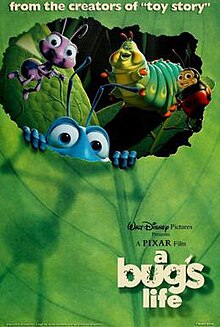| A Bug's Life | |
|---|---|
 Theatrical release poster | |
| Directed by | John Lasseter |
| Screenplay by |
|
| Story by |
|
| Produced by |
|
| Starring | |
| Cinematography | Sharon Calahan |
| Edited by | Lee Unkrich |
| Music by | Randy Newman |
Production company | |
| Distributed by | Buena Vista Pictures Distribution[a] |
Release dates |
|
Running time | 95 minutes[3] |
| Country | United States |
| Language | English |
| Budget | $40–120 million[4][2] |
| Box office | $363.3 million[2] |
A Bug's Life is a 1998 American animated comedy film produced by Pixar Animation Studios for Walt Disney Pictures. It is Pixar's second feature-length film, following Toy Story (1995). The film was directed by John Lasseter, co-directed by Andrew Stanton (in his feature directorial debut), and produced by Darla K. Anderson and Kevin Reher, from a screenplay written by Stanton, Donald McEnery, and Bob Shaw, and a story conceived by Lasseter, Stanton, and Joe Ranft. It stars the voices of Dave Foley, Kevin Spacey, Julia Louis-Dreyfus, and Hayden Panettiere. In the film, a misfit ant named Flik, looks for "tough warriors" to save his ant colony from a protection racket run by a gang of grasshoppers. However, the "warriors" he brings back are a troupe of Circus Bugs. The film's plot was initially inspired by Aesop's fable The Ant and the Grasshopper.[5][6]
Production on A Bug's Life began shortly after the release of Toy Story in 1995. The ants in the film were redesigned to be more appealing, and Pixar's animation unit employed technical innovations in computer animation. Randy Newman composed the music for the film. During production, a controversial public feud erupted between Steve Jobs and Lasseter of Pixar and DreamWorks co-founder Jeffrey Katzenberg due to the parallel production of his similar film Antz, which was released the month prior.
A Bug's Life premiered at the El Capitan Theatre in Los Angeles on November 14, 1998, and was released in the United States on November 25. It received positive reviews for its animation, story, humor, and voice acting. It became a commercial success, having grossed $363 million at the box office. It was the first film to be digitally transferred frame-by-frame and released on DVD, and has been released multiple times on home video.
Cite error: There are <ref group=lower-alpha> tags or {{efn}} templates on this page, but the references will not show without a {{reflist|group=lower-alpha}} template or {{notelist}} template (see the help page).
- ^ Cite error: The named reference
premwas invoked but never defined (see the help page). - ^ a b c Cite error: The named reference
mojowas invoked but never defined (see the help page). - ^ "A Bug's Life". bbfc.co.uk. British Board of Film Classification. Archived from the original on March 2, 2016. Retrieved October 27, 2015.
- ^ Fabrikant, Geraldine (December 28, 1998). "'Prince of Egypt' Is No King at the Box-Office". The New York Times. Archived from the original on May 27, 2015. Retrieved June 16, 2023.
- ^ Maslin, Janet (2016). "A Bug's Life (1998)". Movies & TV Dept. The New York Times. Archived from the original on March 2, 2016. Retrieved June 16, 2016.
- ^ "A Bug's Life – The Tale". pixar.com. Pixar. Archived from the original on December 5, 2010. Retrieved July 24, 2016.